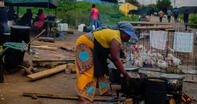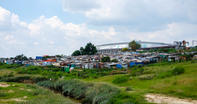The Urban Myth of Prosperity
‘It is a myth that urban populations are healthier, more literate or more prosperous than people living in the countryside,’ writes the Voice of America’s Lisa Schlein and Sven Kruger from the international think tank City Mayors Foundation, after the launch of the UN-Habitat’s report.

In reality, when people pack up their lives and ship themselves into the city, they often bring the same levels of poverty and deprivation that they had experienced back home in the country. ‘In many Sub-Saharan African cities, children living in slums are more likely to die from water-borne and respiratory illnesses than rural children,’ write Schlein and Kruger.
‘Women living in slums are also more likely to contract HIV/AIDS than their rural counterparts.’ Meanwhile, they say that in many developing world cities, ‘child malnutrition in slums is comparable to that of rural areas’.
Measuring Poverty
The ‘dollar a day’ benchmark on measuring poverty has made its way into the modern lexicon. This is the World Bank’s way of placing a yardstick against extreme poverty (although this was bumped up to US$1.25 a day recently). The ‘two dollar a day’ mark is the measure of ‘moderate poverty’, of which 60% of households in the SADC region fall below.
But within the perimeter of the region’s metropolises, 76% of households live on less than US$2 a day. Given the cost of food these days, anything close to a one dollar a day income is not enough to meet even the most basic needs.
‘For example, a loaf of bread in South Africa costs approximately US$1 (at 2008–09 prices), a purchase that would leave the person with no other disposable income, yet with all other basic needs still to be met,’ the African Food Security Urban Network (AFSUN) states in its 2010 publication The State of Urban Food Insecurity in Southern Africa.
What it Means to be Poor

Counting a household’s rands and cents is not necessarily the most accurate way of measuring poverty, though. Another way is to count how often a family cannot get the ‘basic necessities of life’ – a so-called Lived Poverty Index devised by the research initiative Afrobarometer (an institution that surveys attitudes on issues of governance and democracy in the subcontinent, and is associated with the South Africa-based Institute for Democracy in Africa, amongst others).
The Afrobarometer’s living poverty index measures how often a family goes without ‘food, clean water, medicine/medical treatment, cooking oil and a cash income’. In its 2003 survey across fifteen countries on the continent, the institution asked people what they believed it means to be poor. ‘Nearly half.. . responded that it was a “lack of food”,’ says the AFSUN report.
‘Food poverty was seen as even more important than the lack of money or employment.’ The percentage of an urban population living in slums is another way of viewing the extent of poverty in a city – in Africa, 60% of its urbanites live in some kind of shanty town, and in the past decade, 40% were living on less than a dollar a day.
With such an abundance of food all around us in the cities, you would think that, at the very least, people would be able to get their hands on better food than in the depauperate countryside. After all, even though rural people are poor, their idyllic setting does not give them access to pastoral abundance where they may not have a lot of money and a formal house, but at least they have plenty of healthy, nutritious food growing at the back of the property.
Chronic Poverty in Urban Centres
The pages of the recipe book of many tell a stark tale: any food, as long as it is maize. There are not many fresh vegetables or fruits in the ingredients list. And meat is a luxury too grand for an ordinary cookbook. For some it is true that the dream of a better life is realised in the city – for those who are able to find employment and get the cash they need to fill a shopping basket.
Food security in this context is about all households being able to access food, rather than putting more food into the city’s markets. As so many southern Africans find themselves herded by socio-economic forces into the shacklands on the city’s margins, they become even poorer and less food secure, writes the African Food Security Network (AFSUN).
‘The region’s towns and cities are characterized by extreme poverty and are especially vulnerable to disease, environmental stressors and food insecurity. Chronic poverty is increasingly concentrated in urban centres.
Large numbers of people live in urban informal settlements, lack adequate tenure and have poor access to infrastructure and social services. The high costs associated with urban shelter, transport, health and education also undermine the ability of the chronically-poor to access sufficient food.’
Effects of Price Increases
Cities are expensive places to live in. And for those who do not enjoy the comforts of having bounce in their financial bungee ropes: overdrafts, credit cards, a guaranteed and adequate pay cheque at the end of each month – even a small financial knock can pinch a few staple grocery items from the shopping basket. Indeed, the food price increases that started in 2008 pushed an additional 100 million people into chronic hunger (‘the Food and Agriculture Organisation estimated that the number of undernourished passed 1 billion for the first time’ in 2009).
In the same year, when AFSUN asked people in poor communities in our main cities how the food price increases had affected them, 78% of them said that they had had to go without food because of it in the preceding six months.
Those living in slums are particularly ensnared in their poverty, since shacklands are generally further from the resources they need and off the city’s electricity, water or housing grids.
Far from public hubs, for instance, means its costs them more to get themselves through the city’s transport feeder routes to job opportunities, schools, clinics or supermarkets where bulk buying power tends to bring prices down for consumers. Their poverty throws them way out on the edges of the city, making them remote from everywhere and with nowhere else to go.
By Leonie Joubert